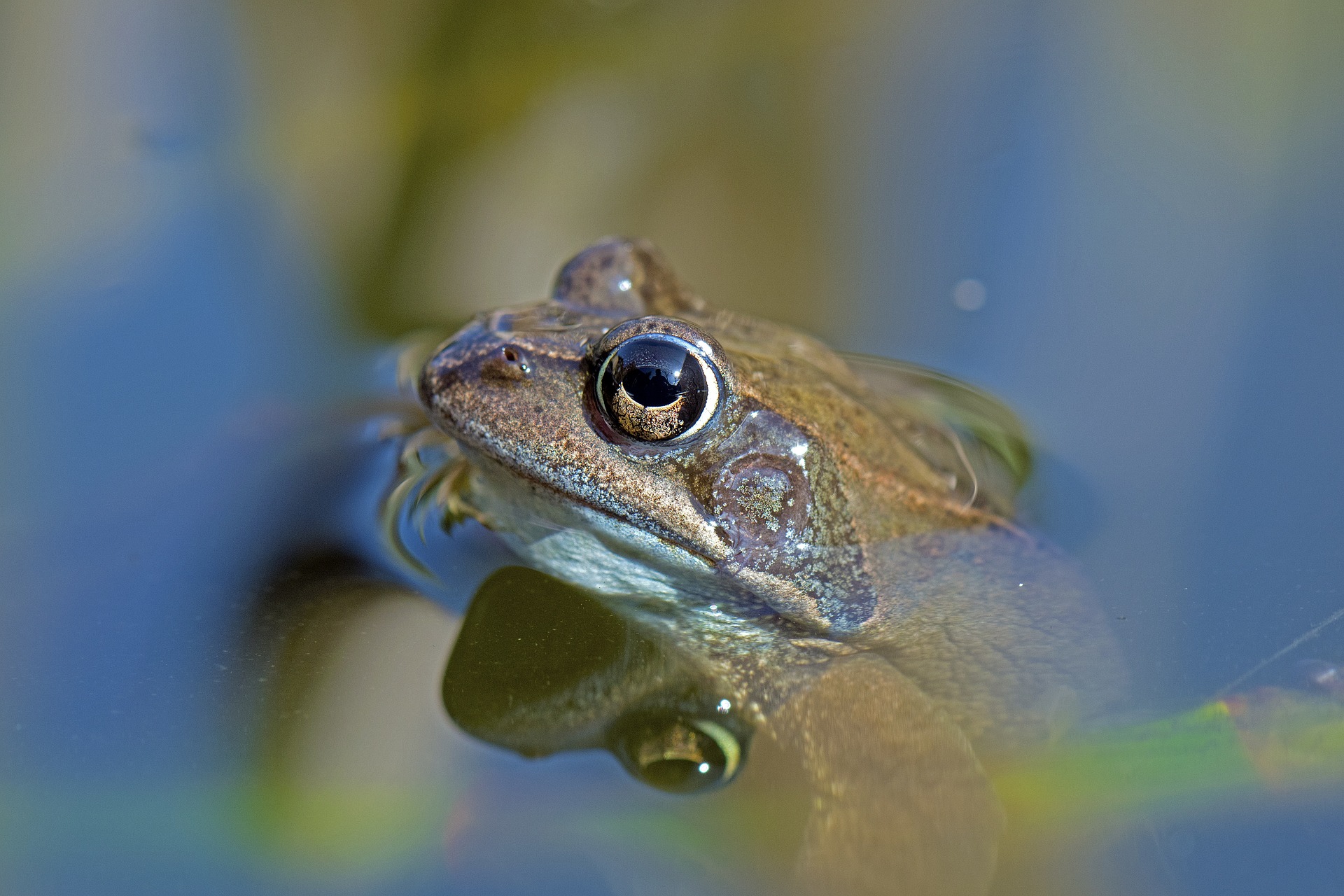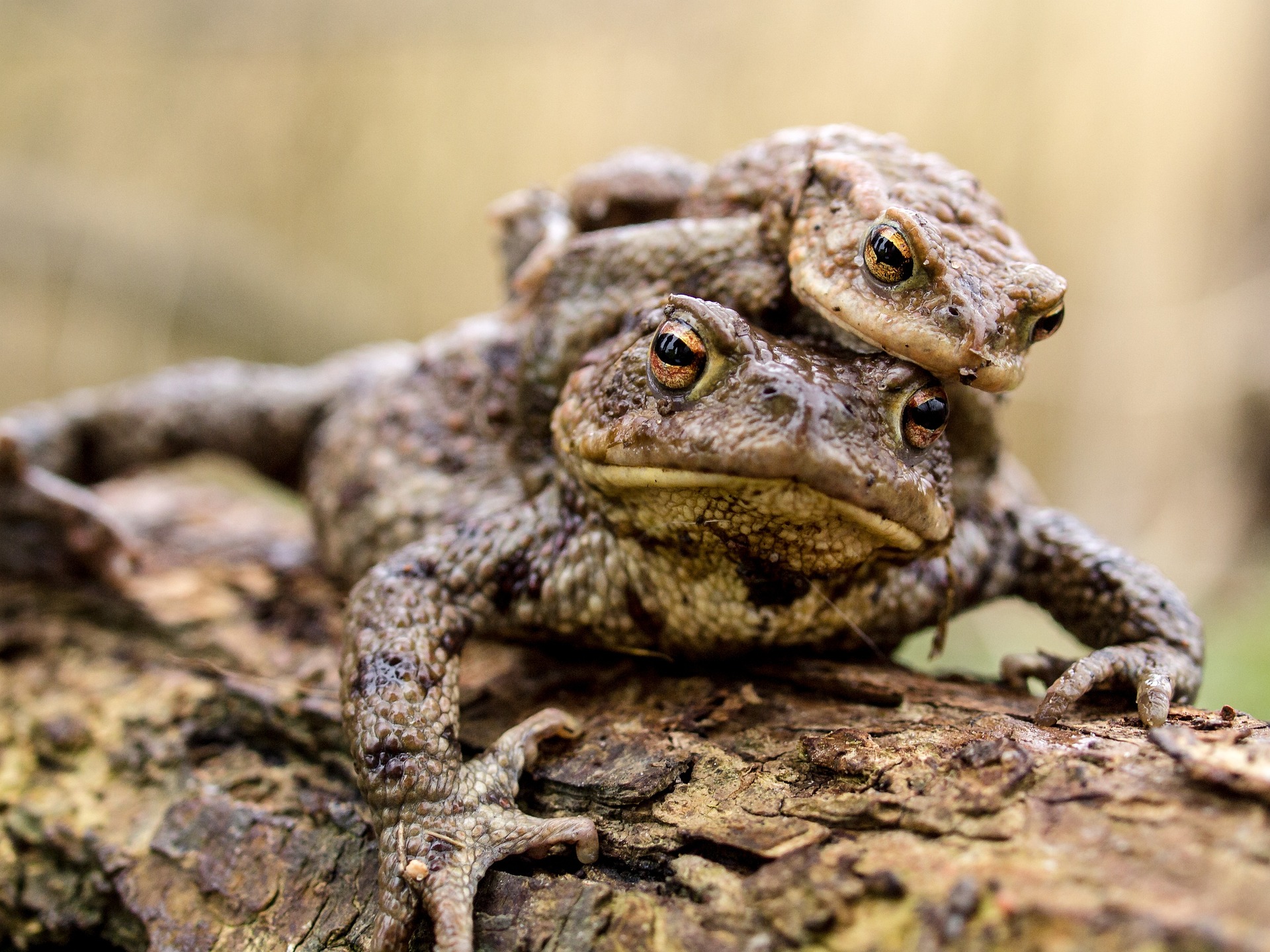Bright side of the night – 2.2.3
Amphibians
Frogs and toads—masters of eyesight
Amphibians, such as frogs or toads, often avoid daylight to protect themselves from dehydration and predators. They prefer the cooler and relatively higher humid night hours. Most frog and toad species are partially or completely nocturnal and have keen eyesight. Due to their permeable skins and their amphibious habitat requirements, these animals are particularly sensitive and acutely endangered.
Common frogs
Commons frogs (Rana temporaria) are found across most of Europe in grasslands, biotopes, bushes, water banks, forests, gardens, parks, and moors. Popular signs of their predominantly nocturnal activity are the frogs’ evenings choruses in summer. Frogs mostly search for food visually, and they can even perceive colors in the dark. They hunt for insects like grasshoppers and beetles, spiders and slugs at night, and they hide in damp places between vegetation, or under stones or deadwood during the day. Common frogs hibernate mainly terrestrially, in holes in the ground and other frost-free shelters, and sometimes at the bottom of water bodies. Around March, the adult frogs who awake from hibernation arrive in the spawning waters. The common frogs’ spawning pads are large and contain about 1000 and 2500 eggs. Under natural conditions, common frogs live up to ten years.
Common toads
Common toads (Bufo bufo) are typical amphibians across Europe, and they even inhabit urban areas as long as they find spawning waters. Toads see extremely well and need only a fraction of the light produced by the starry sky to catch their prey at night: 0.00001 lx (by comparison, the full moon produces a maximum of 0.3 lx). During the day, the animals rest under stones, dead wood, leaves, bushes or in holes they have dug themselves. Before winter, toads crawl into frost-free places such as compost heaps, piles of leaves, tree roots or damp holes in the ground and go into hibernation there. Toads feed on worms, snails, woodlice, spiders and various insects, which they capture during their nocturnal forays. Earth toads pull earthworms through their fingers—“like spaghetti”—before eating them, in order to scrape off dirt particles. The toads’ skin glands produce toxic secretions that serve as defence against predators, but also as protection against infestation of the skin by microorganisms. Common toads move from their wintering grounds to spawning grounds in March or April. Their mass migrations are especially common between dusk and 10 pm. In the wild, toads have a life expectancy of up to twelve years.


Further resources
Links below will redirect you to external websites. In accordance with the European data protection declarations, we would like to point out that by clicking on these links you may send data to external providers. We cannot prevent that.
Images
![]() A vast number of photos of amphibians can be accessed at Pixabay.
A vast number of photos of amphibians can be accessed at Pixabay.
Videos
![]() International Dark-Sky Association: Light pollution effects on Wildlife and Ecosystems
International Dark-Sky Association: Light pollution effects on Wildlife and Ecosystems
![]() Light pollution and the negative effects on nature, humans and the animals
Light pollution and the negative effects on nature, humans and the animals
Online resources
![]()
 The influence of light pollution on plants, animals and ecosystems (Helle Not)
The influence of light pollution on plants, animals and ecosystems (Helle Not)
![]()
 What happens at night just beyond our doorstep? Bothersome-Brightness-Cartoons. (Helle Not)
What happens at night just beyond our doorstep? Bothersome-Brightness-Cartoons. (Helle Not)
![]()
 Verlust der Nacht / Loss of the Night: Interdisciplinary Research network
Verlust der Nacht / Loss of the Night: Interdisciplinary Research network
![]() Into the Night in the Kaunertal Valley (Online publication)
Into the Night in the Kaunertal Valley (Online publication)
 Unterwegs in die Nacht im Kaunertal (Online publication)
Unterwegs in die Nacht im Kaunertal (Online publication)
 Konzept zur nachtbezogenen Naturpädagogik (Online publication)
Konzept zur nachtbezogenen Naturpädagogik (Online publication)
Further readings
![]()
 Regularly updated Literature and links with regards to light pollution and dark skies (Helle Not)
Regularly updated Literature and links with regards to light pollution and dark skies (Helle Not)
![]()
 Literature & Links on the website “Verlust der Nacht/Loss of the Night”
Literature & Links on the website “Verlust der Nacht/Loss of the Night”
![]() Scientific paper on “The effects of artificial lighting on Amphibians”
Scientific paper on “The effects of artificial lighting on Amphibians”
![]() Online summary of studies: The effects of light pollution on amphibians.
Online summary of studies: The effects of light pollution on amphibians.
![]() Scientific paper on “Limitiations of colour vision in dim light with amphibians”
Scientific paper on “Limitiations of colour vision in dim light with amphibians”
 Nachtfibel: Nachts in den Naturparken Luxemburgs
Nachtfibel: Nachts in den Naturparken Luxemburgs
Teaching Material
 10 Europäische Amphibienarten, die Du kennen solltest.
10 Europäische Amphibienarten, die Du kennen solltest.
For Kids
![]()
 Materials for young scientists: Quiz, Arts and craft corner, App and Exhibition for schools. (Loss of the Night network)
Materials for young scientists: Quiz, Arts and craft corner, App and Exhibition for schools. (Loss of the Night network)
 Unterrichtsmaterialien für Schulen – “Tierprofi Wildtiere” (Die Umweltberatung)
Unterrichtsmaterialien für Schulen – “Tierprofi Wildtiere” (Die Umweltberatung)
 Unterrichtsmaterialien für Schulen – “Lichtverschmutzung” (Die Umweltberatung)
Unterrichtsmaterialien für Schulen – “Lichtverschmutzung” (Die Umweltberatung)
 Wissens- und Methodenbox „Kunstlicht, Nacht und Sternenhimmel“ (Naturfreunde)
Wissens- und Methodenbox „Kunstlicht, Nacht und Sternenhimmel“ (Naturfreunde)
 Unterrichtsmaterialien: “Amphibien” (Bund Naturschutz)
Unterrichtsmaterialien: “Amphibien” (Bund Naturschutz)
